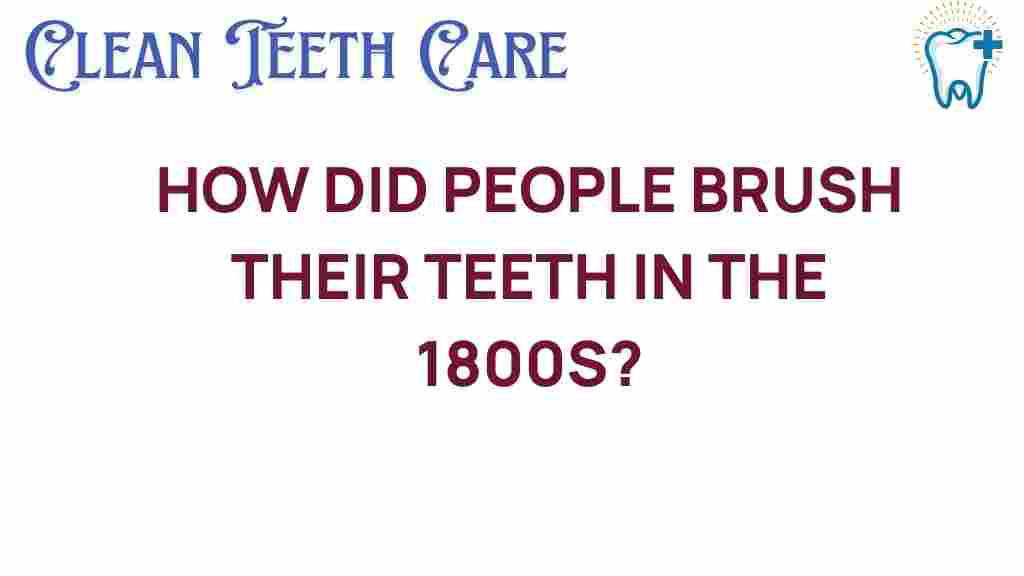Unraveling the Secrets of 19th Century Dental Hygiene
When we think about dental hygiene today, we often take for granted the advanced tools and knowledge we have at our disposal. However, the journey of oral care has been long and varied, particularly during the 1800s. This article delves into the fascinating world of dental hygiene during the 19th century, exploring the practices, beliefs, and tools used in the pursuit of cleanliness and health during the Victorian era.
The Importance of Dental Hygiene in the 1800s
In the 1800s, dental hygiene was not just a matter of aesthetics; it was deeply intertwined with overall health. People believed that poor oral care could lead to serious health issues. While the understanding of germs and bacteria was still in its infancy, the emphasis on cleanliness was paramount. Here are some key points to consider:
- Social Status: A person’s dental hygiene often reflected their social standing. Well-maintained teeth were synonymous with wealth and cleanliness.
- Health Beliefs: It was widely believed that a healthy mouth contributed to overall body health. Tooth decay and gum disease were thought to lead to ailments beyond the mouth.
- Cosmetic Appeal: The Victorian era placed a high value on appearance, and having clean, white teeth was a significant part of that.
Historical Practices of Oral Care
During the 1800s, dental hygiene practices varied significantly based on social class, geography, and access to resources. Here’s an overview of some common practices:
- Tooth Brushing: The toothbrush as we know it today was still evolving. Many people used rudimentary brushes made from animal hair or even their fingers. Brushing was not as routine as it is today.
- Tooth Powders: Instead of toothpaste, people used tooth powders made from ingredients like chalk, baking soda, and even herbal extracts. These powders were intended to clean teeth and freshen breath.
- Rinsing and Gargling: Many individuals used mouth rinses made from vinegar or salt water to maintain oral hygiene.
- Dental Treatments: Professional dental care was limited, especially in rural areas. Tooth extraction was a common solution for dental problems.
The Evolution of Tooth Brushing
The evolution of tooth brushing in the 19th century is particularly notable. Here’s a brief timeline of the advancements:
- Early 1800s: The first mass-produced toothbrushes were made in England, featuring bristles made from animal hair.
- Mid-1800s: The introduction of synthetic bristles began to change toothbrush design, though they were not widely available until later.
- Late 1800s: The development of more ergonomic handles and varied brush types began to cater to different dental needs.
Tools and Ingredients for Oral Care
Understanding what tools and ingredients were used in 19th-century dental hygiene provides insight into the practices of the time:
- Toothbrushes: Early toothbrushes had wooden handles and were often handmade.
- Tooth Powders and Pastes: Common ingredients included:
- Chalk
- Charcoal
- Baking soda
- Salt
- Essential oils for flavoring
- Mouth Rinse: Popular rinses were often made from vinegar, salt, or even whiskey.
Health Implications of Dental Hygiene in the 1800s
Dental hygiene in the 1800s was crucial not only for oral health but also for overall well-being. Poor dental hygiene could lead to:
- Tooth Decay: A prevalent issue leading to pain and extractions.
- Gum Disease: Often caused by inadequate cleaning methods.
- Systemic Health Issues: Emerging beliefs suggested links between oral health and diseases like heart disease.
Troubleshooting Common Dental Hygiene Issues
Even with the limited knowledge of the time, individuals faced common dental hygiene issues. Here’s how they approached troubleshooting:
- Bad Breath: Gargling salt water or using herbal rinses was common.
- Tooth Sensitivity: People often avoided very hot or cold foods to manage discomfort.
- Stained Teeth: Charcoal and baking soda were popular for attempting to whiten teeth.
Victorian Attitudes Towards Cleanliness
During the Victorian era, cleanliness was not just a personal preference but a societal expectation. This era emphasized:
- Public Health: The link between cleanliness and health was being acknowledged, leading to public health campaigns.
- Home Remedies: Many people relied on homemade solutions for oral care, often passed down through generations.
- Social Norms: Having a clean mouth and smile was seen as a reflection of character and propriety.
Modern Implications of 19th Century Practices
While dental hygiene has evolved significantly since the 1800s, some practices and beliefs from that time laid the groundwork for modern oral care. Today, we can see:
- Continued Emphasis on Cleanliness: The Victorian focus on cleanliness continues in today’s dental hygiene practices.
- Natural Remedies: The resurgence of interest in natural toothpastes and powders reflects an ongoing fascination with historical practices.
- Awareness of Oral Health Impact: Current research supports the link between oral health and overall health, echoing the beliefs of the past.
Conclusion
Unraveling the secrets of 19th-century dental hygiene reveals a complex tapestry of practices that speak to the values and beliefs of the time. From the rudimentary tools like early toothbrushes to the use of tooth powders and rinses, individuals in the 1800s took steps to maintain their oral health, albeit with a limited understanding of modern dental science. The Victorian era’s emphasis on cleanliness and health has left a lasting legacy, influencing how we approach dental hygiene today.
As we reflect on the historical practices of oral care, it’s essential to appreciate the advancements that have been made since then. For more information on modern dental hygiene practices, visit this resource.
In conclusion, the journey of dental hygiene from the 1800s to today illustrates the evolution of human understanding of health and cleanliness. By learning from the past, we can continue to improve our oral care practices for a healthier future.
This article is in the category Hygiene and created by CleanTeethCare Team
